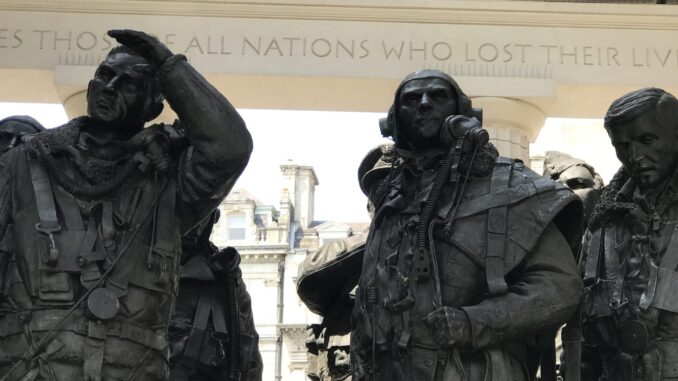
Over 55,000 Bomber Command crew lost their lives during the second world war – a death rate of over 44% from those who served. Thousands of others were killed in training, wounded, or shot down and taken prisoner. A Bomber Command crew member had a worse chance of survival than a junior infantry officer in WW1 (usually the benchmark for combatants’ slaughter).
A tour of operations was 30 missions and the chances of surviving those unscathed was less than 30% The risks and the casualties are almost beyond imagining.
But there was no memorial to those that flew until Liam O’Connor and Philip Jackson’s monument in Green Park was unveiled by Elizabeth II in 2012. That delay gives some indication of how controversial the allied strategy of ‘area bombing’ rapidly became after the war.
Because the weight of bombs dropped and the numbers of people killed – the majority of whom were civilians – is truly terrifying. Bomber Command dropped over 1 million tonnes of high explosive on Germany and occupied Europe during the war (with a similar amount dropped in daylight raids by the USAAF). German civilian deaths as a result of the bombing could be as many as 650,000 (or more – precise figures are impossible).
For comparison, 60,000 UK civilians were killed by bombing over the entire period of the war. In the 9 months of the Blitz – September 1940 to May 1941 – across the whole of the UK some 30-40,000 tonnes of bombs were dropped and around 43,000 people killed. This is almost exactly the same as the estimated fatalities in Hamburg in one week of Allied raids in July 1943. “They have sown the wind, and they are going to reap the whirlwind” as Air Marshal Arthur Harris, the head of Bomber Command rather chillingly prophesied in June 1942.
The effectiveness of the Allied strategic bombing campaign – its impact on German industry, the allocation of Nazi resources to air defence that could have been used against the Red Army or in Normandy – is still a matter of debate, but it is certainly true that such indiscriminate attacks would be regarded as war crimes today (think of Assad in Syria, or Russian strikes on Ukraine’s cities).
Even without projecting 21st century mores onto the total war of over 80 years ago, there was ambivalence about the campaign in the 1940s, hence it taking until last decade before the Bomber Command crews received this public, national, memorial.
The structure was designed by Liam O’Connor, who was also the designer of the Commonwealth Memorial Gates at the top of Constitution Hill, and the Armed Forces Memorial in the National Memorial Arboretum. It is a classical building, with columns facing both into Piccadilly and Green Park, within which are sculptures by Philip Jackson, of seven aircrew – representing the number on the Lancaster bomber, the main aircraft for night bombing.

The roof, which incorporates sections of aluminium recovered from a RCAF Halifax shot down over Belgium in 1943 with the loss of its eight crew, is open to the sky to allow light to fall directly onto the sculptural group beneath. It also has the effect of making the sky itself part of the work; look up at the sculptures and they are framed by the sky above. To quote Yeats (about an airman of the first world war):
I know that I shall meet my fate Somewhere among the clouds above; Those that I fight I do not hate, Those that I guard I do not love
Which ends
In balance with this life, this death.



